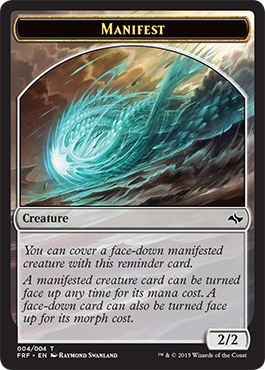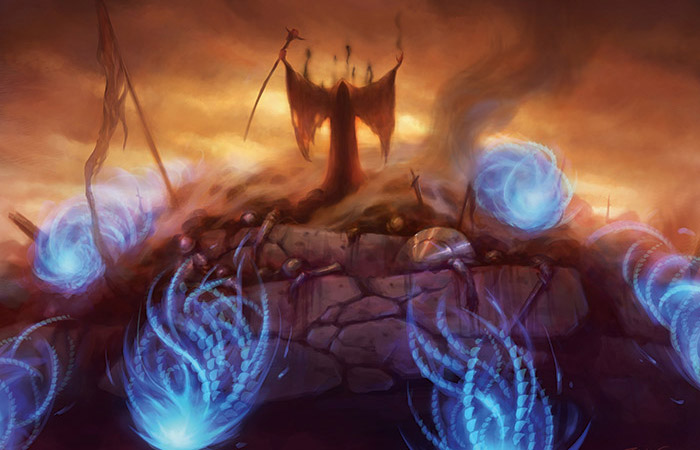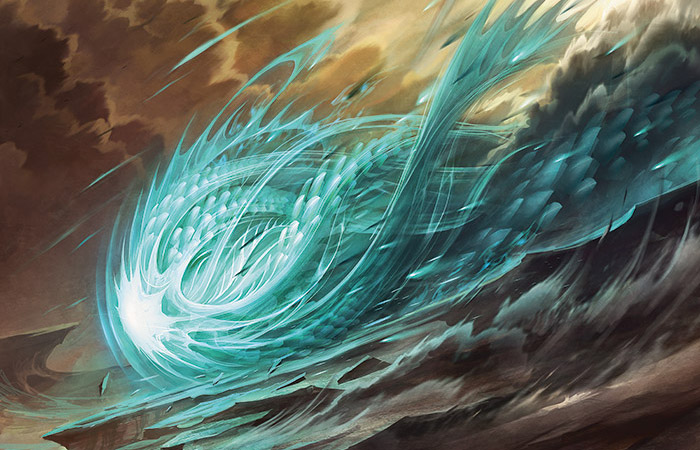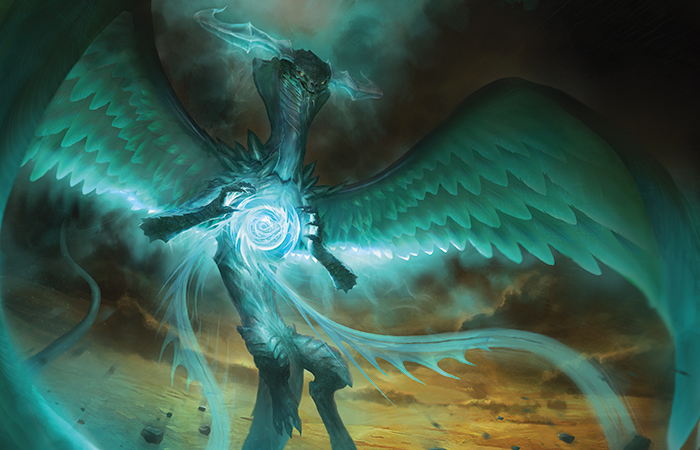Manifest Destiny
It's Manifest Week, so we'll be talking all about Fate Reforged's new proto-morph mechanic. As I already talked about manifest's design during preview weeks, I thought I'd use my article today to talk in depth about a number of questions players have about manifest.
Why can you only cast face-down creatures with manifest? Why not any type of spell?
There are a couple different answers to this question, so I'll run through them all.
- Flavor—Manifest is meant to represent the proto-version of morph. It is draconic magic used to create faceless creatures. In the original Tarkir timeline, the humans were able to get their hands on the draconic magic and over time adapted it to create magic with the purpose of hiding identities used as a means to help win combats. There is some thought that it was this magic that helped the clans finally kill off all the dragons. Morph only turns up creatures (in Khans of Tarkir) so to flavorfully create a connection, manifest also only turns up creatures.
- Complexity—Turning from a creature into not a creature, especially during combat, can create very complicated interactions. By restricting the change to creatures, manifest creatures can never change card type, keeping us from adding more complexity to an already complex mechanic.
- Rules—The game does not like having nonpermanents on the battlefield. Yes, there are some interactions between Onslaught cards and manifest that try to do this (and thus forced the rules to define what happens—it can't occur so the game puts the cards back face down), but the less this tries to happen, the better.
- Costing—Having the ability to turn up any card type is a much stronger effect, forcing development to cost the spells higher and making manifest appear less attractive in the costing.
- Gameplay—Game design is about challenging the player. To do this, the game designer has to often restrict what the player is able to do, thus forcing the player to work within the restrictions. In other words, allowing the players to do whatever they want does not often lead to better gameplay.

Isn't manifest too complex for New World Order?
No question, manifest is in the gray area. It's definitely pushing at the boundaries of what's acceptable, but Magic is a game all about taking risks and we felt this mechanic was fun enough and thematic enough to the story to give it a go. Just as we are willing to occasionally walk the line on power level, so too are we on complexity. It's not something we want to constantly be doing, but on occasion we will find a mechanic in the gray area where it makes sense to push. I believe manifest is one of those mechanics, but just as when we push card power level, that doesn't mean we might not look back in hindsight one day with a different opinion.
One of the big reasons we decided we were comfortable with doing manifest at common was the fact that morph was in the previous set in the block. Now, I'm sure some of you are surprised, as morph is a complex mechanic that itself is in the gray area of New World Order. Why would having two complex mechanics make things any better? The answer is that, while these two mechanics are complex, they are complex in the exact same areas. Learning morph teaches you most of the complex things about learning manifest. Let me explain.
Lesson #1—Cards in Magic can be turned face down and become 2/2 colorless creatures
This is probably the most difficult idea to grasp when you first face morph (or now, manifest) because it's something that fundamentally breaks a mostly ironclad rule of the game—that card backs have no in-game function. When you first interact with a mechanic that deals with face down cards you have to learn that Magic does allow them, within certain limits, and that it defines them as being something specific—a colorless 2/2 creature with no name or creature type.
Lesson #2—Face-down cards have the ability to be turned face up
Not only is a face-down card a 2/2 creature, but under the right circumstances, it can turn face up and become whatever the card is on its front. To do this, there is an amount of mana that has to be paid, which is explained on the front face of the card. Barring a handful of futureshifted cards (from the set Future Sight), all face-down cards when turned face up turn into creatures. (Yet another reason manifest only turns creatures face up.)
Lesson #3—Turning a face-down creature face up doesn't use the stack
Normally, when a player does something, the opponent has the ability to react. There are a handful of cases where the opponent doesn't. Face-down cards turning face up is one of them.
If you understand how morph works, you understand all the lessons above. That gets you very far along the path of understanding how manifest works. In fact, if we had wanted to, we might have even been able to write manifest through the lens of the morph mechanic. Manifest having its own name was splashier and let us write the cards cleaner, but the point is that you can very easily think of how manifest works through the lens of how morph works.
Only one card manifests from a zone other than your library? Why is that? Why not, for example, manifest from your hand?
During design, we experimented with manifesting from different zones, and playtesting showed that the most interesting zone was the top of your library. Let me explain why. The possible zones to get cards from are: hand, graveyard, battlefield, exile zone, inside your library, and on top of your library. (In theory, you could have also included each of the zones of another player, but that creates gameplay where you have an opponent's card hidden on your side of the battlefield, and we avoid making black-bordered cards where your opponent can't easily watch a card of his or hers that's been taken.)
Let's walk through each of these options:
Hand
This zone has zero surprise (and doing it randomly would be highly frustrating) and would have led to the manifested card being a creature a high percentage of the time. So much so that it would miss the mystery that comes with the manifest mechanic. Also, it's pretty powerful, meaning the mana cost for cards from this zone would have been high.
Graveyard
This misses the mystery component that makes manifest shine. The graveyard is a public zone, so what card you manifest would always be known. Note that the one card that does manifest from the graveyard takes steps to hide what each manifest creature is.
Battlefield
This zone both would have zero surprise and be conceptually a bit weird. It also would mostly be used to turn noncreature permanents into creatures.
Exile Zone
The exile zone is meant to be a place where things go and don't return. We allow cards to exile other cards or themselves and then bring those cards back, but we try to avoid allowing players to get back cards exiled by other means—especially cards players have exiled themselves, because that is where broken interactions are most likely to happen.
Inside Your Library
Once again, this zone would function just like a tutor and thus would miss some of the mystery. Also, like the hand, cards taken from this zone would almost always be a creature. It also requires shuffling.
On Top of Your Library
This zone mostly has surprise and doesn't allow the player too much control (although with things like deck manipulation it allows a little bit).
Note this doesn't mean we couldn't explore some of these zones in the future if manifest ever returns, but as the first time out of the gate, we felt mostly manifesting from the library was the easiest and best-playing way to go.

Ghastly Conscription | Art by YW Tang
Why do you have to reveal your manifest cards when the game ends if there's no way to cheat with the mechanic?
One of the things that's important in game design is consistency. Here's why. You want your players to have the ability to keep track of the things they need to when playing the game, but human brains have limits and there's just so much they can keep track of. To help them, game designers want to play into a mental concept known as "chunking."
Chunking is basically the brain taking disparate things that have some connection and thinking of them as a singular thing. Phone numbers (in the United States, at least) aren't written out as ten separate numbers but rather as three groups of numbers—a three-digit area code, a second three-digit code, and a four-digit code.
Part of making a game easy to play is trying to take sections of it and organize them such that they are easy for players to chunk. This is most often done by having similar game elements function in the same way. We do this often with rules, for instance. Above, I talked about how morph and manifest both don't use the stack. This was done to make sure there was consistency with how turning a face-down card face up worked.
Because of morph, the game already has a rule for what happens when a face-down card leaves the battlefield or the game ends—you reveal it. When we created manifest, we had two options. We could say manifested face-down cards work differently than morph or we could say they work the same way. Working the same way was much easier because you don't have to know whether a face-down creature was cast with morph or manifest. Just reveal it.
And yes, I understand that in tournament play you're required to make it clear how each face-down card was cast, but that attention to detail is not extended to a lot of casual play. The consistency of the rule keeps players who don't want to care from having to care.
How did the three enchantments that become Auras (Cloudform, Lightform, and Rageform) happen?
I think the earliest version came about because the design team was trying to figure out different ways to alter what the manifested creature was. Early on, we figured the technology of using +1/+1 counters. The big question, though, was if there was a way to graft on evergreen keyword abilities.
Creature keywords other than haste became memory issues. This is especially bad because you often have multiple manifest creatures on the battlefield, so remembering that "this one flies while this one doesn't" without any object(s) to help you remember seemed suboptimal.
We then stumbled upon the idea of using creature Auras. What if the Aura manifested and then attached to the creature? We tried it and they were fun, but with just one small problem. It didn't work within the rules. Auras have to target when cast and the manifested creature doesn't exist until the spell resolves. Eventually, with the help of Rules Manager Matt Tabak, a solution was found. The cards could be enchantments that turned into Auras when they entered the battlefield. It was a little wonky but the cards played well enough that we decided it was worth the wonkiness.
Why are there only three? Because we chose to do them as a cycle in Jeskai colors. Manifest cards worked especially well with prowess and the cycle seemed like a good fit.
Why 2/2? Morph already does 2/2. Why not a different power/toughness combination?
The answer to this is we can't and we wouldn't want to.
We can't because the game defines what a face-down creature is and that definition has to be a single consistent thing. This all came about years ago because the rules team was trying to make the cards Illusionary Mask and Camouflage work, and they realized that the key to doing it was to have the game provide a property to face-down cards. My contribution to this story is I convinced them to make it a 2/2 rather than a 1/1.
We wouldn't want to because having different face-down cards be different power/toughness combinations (without reminders like +1/+1 counters or Auras) would be very hard to process. We already spend a lot of time trying to consolidate tokens for the same type of processing issues.
Was there any pushback from R&D with manifest?
Yes, there was. When we first presented the mechanic, there was a lot of doubt about it. Then, during "devign" (when design still has control of the file but development starts meeting to give feedback), with notes from development, we added in the ability to turn creatures face up, making the mechanic even more complicated. There were a lot of questions about the complexity and if the mechanic was worth the cost of using it. Our response was just, "Play with it. Yes, it's on the complex side and, yes, it has some logistical issues, but it's fun. It's really fun. Play with it."
The Fate Reforged development team was skeptical when development began, but Development Lead Dave Humpherys believed in manifest and pushed for the team to play with it. They did and they also found it very fun. Multiple times during the process the question was brought up of: "Was manifest worth the extra cost it added to the set?" The answer kept coming back: "Yes."
So there was a decent amount of pushback in both directions.
Why not just more morph?
One of the things that was important with the block plan was that we really wanted to hit home the idea of present/past/altered present. To do that, it was important to have one mechanic that could serve as the mechanical backbone of this journey. It too had to be present/past/altered present.
In order for morph to be this mechanic, we knew we had to do something fundamentally different with it in the past. Just having more morph didn't feel as if it would feel substantial enough. I should note that when we were exploring for a "proto-morph, we did experiment with some morph variants, but none of them captured the feel we wanted from the mechanic like manifest.
Manifest feels more complicated than morph. Is it really a "proto" version?
I think some of manifest's complication comes from its newness. If morph and manifest had been introduced in the reverse order, I do believe that morph would feel more like an offshoot of manifest than manifest would feel like an offshoot of morph. The fact that we experienced them chronologically in the opposite direction is what I believe creates the effect you're asking about.

Manifest Overlay | Art by Raymond Swanland
The thing I like about manifest flavorfully is that it is magic that hints at what morph will one day become without exactly being morph. I feel like manifest was invented for a different purpose, but the humans latched on to the secretive quality of it and adapted the magic as a means to hide the identity of their troops from the enemy.
Imagine if you had never seen morph before but rather had seen manifest first. When morph was introduced it would feel like you took the creature part of manifest and grafted it to creatures. Rather than sometimes hitting a creature, what if the mechanic just came on creatures?
What happen when you manifest a morph creature?
The morph ability allows you to cast the card for three generic mana to play it as a face-down 2/2, but morph also has a second ability that is the ability to turn the creature face up. That second ability works no matter how the card got face down on the battlefield. This means that if you manifest a morph card face down, that card can be turned up by its morph cost or, if it's a creature, by its mana cost. Both costs work.
Why manifest from the top of library versus bottom?
The major reason is there are just a lot more cards that allow you the ability to interact with the top card of your library. A lot of Magic's depth comes from the interaction of its cards, so whenever we can make choices that play up synergy between cards we tend to err in that favor (although not always, because sometimes synergy causes power-level issues).
When was it decided that manifest was going to represent Ugin's magic?
The time-travel block structure predated the individual choices of what the world was going to be or how it was going to change, so manifest (originally called recruit) was created long before Ugin was even in the set. Once we settled upon a warlord world that had killed off its dragons, that led us to this being Sarkhan's home world, and that led to the idea of having Ugin involved, as he's been a major player in the Sarkhan story.

Ugin Booster Alternative Art Soul Summons | Art by Johann Bodin
We wanted the face-down component of the block tied to the core of the story, so once we knew that the key component of the second half was dragons, it was tied to draconic magic. Then, once we knew that the major player of the dragons was Ugin, it was tied to Ugin. So the answer to the question is, "As soon as we knew Ugin was going to be in the story."
How does manifest work with double-faced cards?
Of all the things in Magic, it was the double-faced cards that probably proved to be the stickiest wicket for manifest. How exactly can you have a double-faced card "face down"? This led to all sorts of debate because a double-faced card is in some way "face down" on top of your library. Until you play it, your opponent doesn't know either side of a double-faced card. Could manifest take advantage of that?
I know Matt Tabak spent a lot of time on this question. He often joked with me how much time was spent on an interaction that wasn't even in the set! In the end, Matt settled on the idea that cards have an unknown side while in the library and it was possible to manifest a double-faced card off the top of your library without revealing the nature of it being a double-faced card. "Are you happy?" he said to me one day, "We've made triple-faced cards."
It's a Manifesto!
That's all the time we have for today. I hope I was able to answer a lot of the questions people have about the manifest mechanic. I hope that you all have had a chance to play with it and agree with us that it is fun enough to be worth its inclusion in the set. As always, I am happy to hear any feedback on today's article or any of the info within. You can email me or contact me through any of my social media (Twitter, Tumblr, Google+, and Instagram).
Join me next week when I'll take you to our leaders.
Until then, may you manifest a lot of creatures.
"Drive to Work #198—Holiday Cards"
This podcast explores the design of the special holiday cards we release each December.
"Drive to Work #199—Feedback"
In this podcast, I talk all about the importance of feedback.
- Episode 199 Feedback (16.5 MB)
- Episode 198 Holiday Cards (16.9 MB)
- Episode 197 Play Testing (14.1 MB)
- Episode 196 2006 (16.7 MB)
- Episode 195 Scourge, Pt. 4 (15.2 MB)
- Complete Drive To Work Podcast Archive

